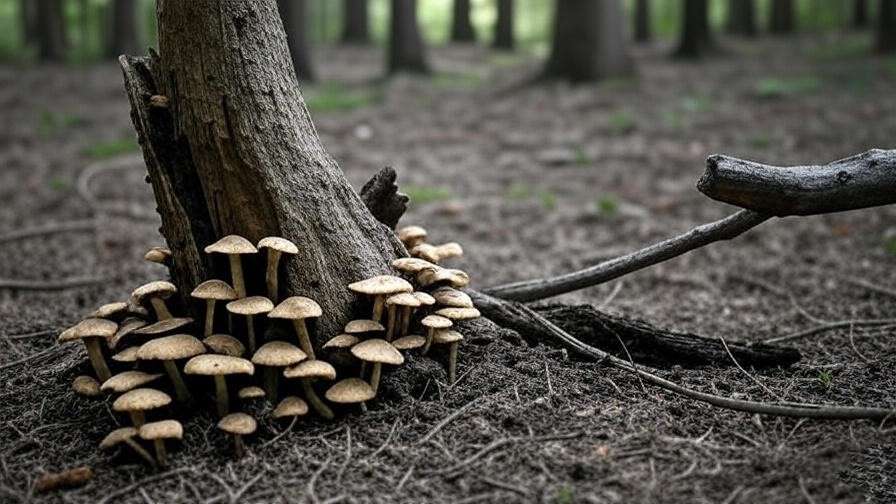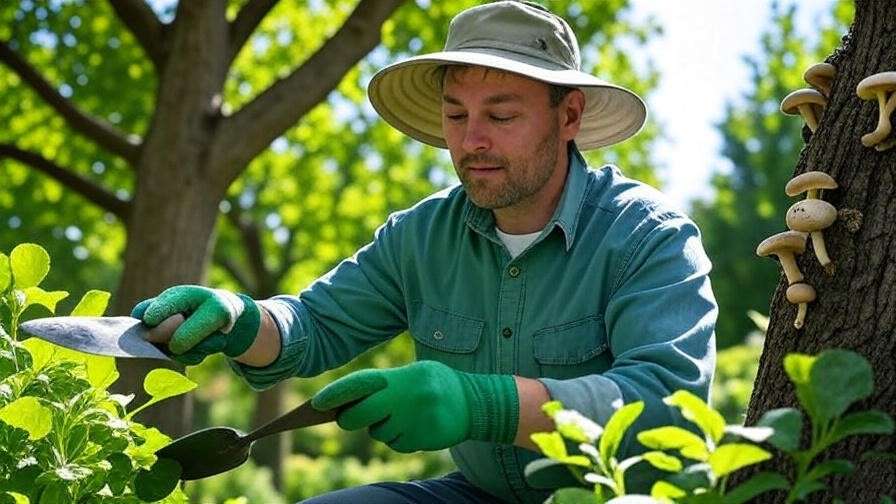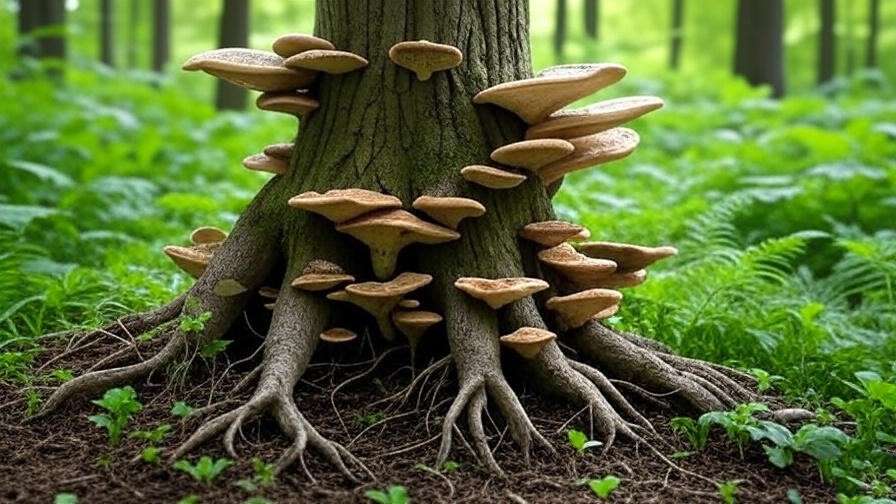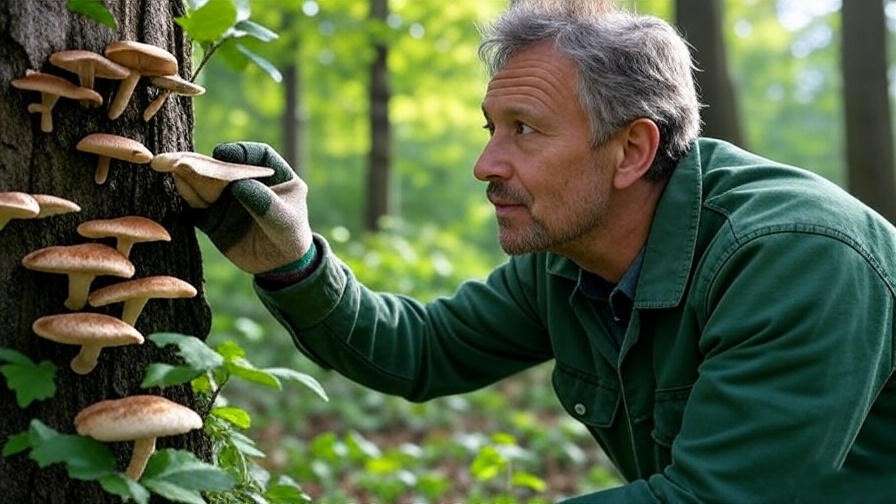Picture this: you’re strolling through your garden, admiring your towering oak, when you spot something unusual—mushrooms from trees sprouting at the base or clinging to the trunk. Are these fungi friends or foes? For gardeners and homeowners, mushrooms from trees can spark curiosity and concern. Are they a sign of a dying tree, or just nature doing its thing? In this comprehensive guide, we’ll unravel the mystery of tree fungi, equipping you with expert knowledge to identify, manage, and prevent fungal growth while keeping your trees vibrant and healthy. As a certified arborist with over a decade of experience in mycology and tree care, I’ll share practical, science-backed strategies to ensure your trees thrive. 🌲
Whether you’re a seasoned gardener or a homeowner new to tree care, this article will empower you to tackle fungal growth with confidence. From spotting harmful fungi to adopting preventive practices, you’ll find actionable insights to protect your trees and enhance your landscape’s beauty.
What Are Mushrooms from Trees? Understanding the Basics 🌿
Defining Tree Fungi and Their Role
Mushrooms from trees are the visible fruiting bodies of fungi, often appearing as caps, shelves, or clusters on trunks, branches, or roots. These fungi are part of a larger network of mycelium—thread-like structures living within the tree or soil. Fungi play a critical role in ecosystems, breaking down dead organic matter and recycling nutrients. However, when they appear on living trees, they can signal underlying issues like decay or stress. Understanding their role helps gardeners differentiate between beneficial and harmful fungi.

Common Types of Tree Fungi
Several fungal species commonly grow on trees, each with distinct characteristics:
- Bracket/Shelf Fungi: These, like Ganoderma species, form shelf-like growths on trunks and often indicate internal decay.
- Honey Mushrooms (Armillaria): Found at the base or on roots, these can be highly destructive, causing root rot.
- Turkey Tail (Trametes versicolor): Colorful and fan-shaped, these are typically saprophytic, feeding on dead wood.
- Oyster Mushrooms: Occasionally found on decaying trees, these are less harmful but still warrant inspection.
Each type offers clues about your tree’s health, making identification a crucial first step.
Why Do Mushrooms Grow on Trees?
Fungi thrive in moist, shaded environments or on trees weakened by stress factors like:
- Physical Damage: Wounds from pruning, storms, or lawn equipment create entry points for fungi.
- Poor Soil Conditions: Compacted or waterlogged soil stresses roots, inviting fungal infections.
- Environmental Factors: High humidity or prolonged wet seasons encourage fungal growth.
Understanding these triggers helps you address the root causes of fungal issues.
How to Identify Mushrooms from Trees 🔍
Visual Identification Tips
Identifying mushrooms from trees requires keen observation. Here’s what to look for:
- Shape and Texture: Are they shelf-like, clustered, or cap-shaped? Bracket fungi are hard and woody, while honey mushrooms have slimy caps.
- Color: Turkey tails boast vibrant bands of color, while Ganoderma species are often reddish-brown.
- Location: Mushrooms on roots suggest root rot, while trunk growth may indicate heartwood decay.
- Examples: Ganoderma applanatum forms large, shelf-like conks, while Armillaria mellea appears as honey-colored clusters.
High-quality images or a field guide can aid identification. Apps like iNaturalist are also excellent tools for beginners.
Signs of Harmful vs. Benign Fungi
Not all fungi spell trouble. Here’s how to tell:
- Harmful Fungi: Extensive growth, soft or crumbly wood, or mushrooms spreading from roots to trunk (e.g., Armillaria causing root rot).
- Benign Fungi: Surface-level growth on dead branches or logs, with no visible impact on living tissue (e.g., turkey tail on a fallen limb).
Regular inspection helps catch harmful fungi early, preventing further damage.
Tools and Resources for Accurate Identification
For precise identification:
- Field Guides: “Mushrooms of the Northeast” by Teresa Marrone is a reliable resource for regional fungi.
- Apps: iNaturalist or Seek by iNaturalist uses AI to identify fungi from photos.
- Expert Consultation: Local mycologists or arborists can confirm species and assess tree health.
Expert Tip: Always cross-reference your findings with multiple sources to ensure accuracy.
Are Mushrooms from Trees Dangerous? Assessing Risks ⚠️
Impact on Tree Health
Mushrooms from trees can signal serious health issues:
- Wood Decay: Bracket fungi like Ganoderma break down heartwood, weakening tree structure.
- Root Rot: Armillaria species attack roots, starving trees of water and nutrients.
- Reduced Lifespan: Chronic fungal infections can shorten a tree’s life, especially if untreated.
Regular monitoring is key to catching these issues before they escalate.

Potential Hazards to Property and Safety
Fungal decay poses real risks:
- Falling Branches or Trees: Weakened trees are prone to failure, especially during storms. In 2023, a decayed maple in Ohio collapsed, damaging a home—highlighting the stakes.
- Property Damage: Root rot can destabilize trees, threatening structures or landscapes.
- Safety Concerns: Falling limbs pose risks to people, pets, and property.
Case Study: A homeowner ignored bracket fungi on their ash tree, leading to a costly removal after the tree split during a windstorm. Early intervention could have saved the tree.
When to Worry and When to Relax
- Worry: Large fungal growths, soft wood, or mushrooms at the base of a living tree.
- Relax: Small, isolated mushrooms on dead branches or logs, with no signs of decay in living tissue.
Expert Tip: Schedule annual tree inspections to catch issues early and avoid surprises.
How to Safely Manage Mushrooms from Trees 🛠️
Step-by-Step Guide to Safe Removal
Removing visible mushrooms can reduce spore spread, but it’s not a cure. Follow these steps:
- Wear Protective Gear: Use gloves and a mask to avoid inhaling spores.
- Gently Remove Mushrooms: Use a trowel or knife to cut mushrooms away, avoiding damage to the tree.
- Dispose Properly: Place mushrooms in a sealed bag and discard to prevent spore dispersal.
- Clean Tools: Sterilize tools with alcohol to avoid spreading fungi to other trees.
Note: Removal addresses symptoms, not the underlying fungal infection.

Addressing Underlying Tree Health Issues
To manage fungi effectively:
- Improve Soil Drainage: Ensure soil isn’t waterlogged; add organic matter to enhance aeration.
- Prune Properly: Remove dead or infected branches with clean, sharp tools to reduce fungal entry points.
- Optimize Watering: Avoid overwatering; aim for deep, infrequent watering to promote strong roots.
- Fertilize Wisely: Use balanced fertilizers to boost tree vigor without encouraging fungal growth.
Expert Insight: Healthy trees are more resistant to fungal infections, so prioritize overall tree care.
When to Call a Professional Arborist
Seek expert help if you notice:
- Extensive fungal growth or decay.
- Mushrooms at the base of a living tree.
- Signs of structural instability (e.g., leaning or cracking).
Certified arborists can assess tree health, recommend treatments, or safely remove hazardous trees. The International Society of Arboriculture (ISA) offers a directory to find local experts.
Preventing Fungal Growth on Trees 🌱
Cultural Practices for Tree Health
Preventing mushrooms from trees starts with proactive care to keep trees strong and resilient. Here are key practices to adopt:
- Proper Pruning: Use clean, sharp tools to make precise cuts, avoiding jagged wounds that invite fungi. Prune during dormant seasons to minimize stress.
- Mulching Correctly: Apply a 2–4 inch layer of organic mulch (e.g., wood chips) around the tree base, keeping it away from the trunk to prevent moisture buildup.
- Soil Management: Test soil pH and nutrient levels annually. Amend with compost to improve soil structure and support root health.
- Avoid Mechanical Damage: Protect trees from lawnmower or trimmer injuries, which create entry points for fungi.
Expert Tip: Always follow the “3-cut method” for pruning large branches to prevent bark tearing and fungal infection.

Environmental Factors to Control
Fungi thrive in specific conditions, so managing your landscape’s environment is critical:
- Moisture Control: Ensure proper drainage by grading soil away from tree bases. Avoid overwatering, especially in clay-heavy soils.
- Air Circulation: Space trees appropriately and prune dense canopies to improve airflow, reducing humidity that fuels fungal growth.
- Shade Management: Thin out surrounding vegetation to allow sunlight to reach tree trunks, discouraging moisture-loving fungi.
Example: In a 2024 study by the USDA Forest Service, improved air circulation reduced fungal infections in urban trees by 20%.
Choosing Resistant Tree Species
Some trees are naturally more resistant to fungal infections. Consider these options based on your region:
- Eastern U.S.: Red maple (Acer rubrum) and white oak (Quercus alba) show strong resistance to root rot.
- Western U.S.: Ponderosa pine (Pinus ponderosa) and California live oak (Quercus agrifolia) are less prone to fungal decay.
- Native Species: Choose trees adapted to your local climate and soil, as they’re better equipped to fend off fungi.
Consult your local extension service for region-specific recommendations. For example, the University of California Cooperative Extension provides tailored guides for West Coast gardeners.
Busting Myths About Mushrooms from Trees 🕵️♂️
Common Misconceptions
Misinformation about tree fungi can lead to poor management decisions. Let’s debunk common myths:
- Myth: All mushrooms on trees mean the tree is dying.
Reality: Many fungi, like turkey tail, are saprophytic, feeding only on dead wood without harming living trees. - Myth: Removing mushrooms cures the problem.
Reality: Visible mushrooms are just fruiting bodies; the underlying mycelium remains, requiring broader treatment. - Myth: Fungi always harm trees.
Reality: Some fungi, like mycorrhizal fungi, form symbiotic relationships that enhance nutrient uptake.
The Truth About Fungi and Trees
Fungi have complex roles in tree ecosystems:
- Saprophytic Fungi: Break down dead wood, contributing to soil health.
- Pathogenic Fungi: Cause diseases like root rot or heartwood decay, requiring intervention.
- Symbiotic Fungi: Mycorrhizal fungi improve tree vigor by aiding nutrient absorption.
Expert Insight: Understanding these roles helps gardeners make informed decisions rather than panicking at the sight of mushrooms.
FAQs About Mushrooms from Trees ❓
Can I Eat Mushrooms Growing on My Tree?
Most mushrooms from trees are not safe to eat unless identified by a professional mycologist. For example, while oyster mushrooms are edible in some contexts, those on trees may be contaminated or misidentified. Always consult an expert before consuming wild fungi.
Do Mushrooms Always Indicate a Dying Tree?
Not necessarily. Saprophytic fungi on dead branches or logs don’t harm living trees. However, mushrooms at the base of a living tree, like Armillaria, may signal serious issues like root rot.
How Often Should I Check My Trees for Fungi?
Inspect trees at least twice a year—spring and fall—when fungal growth is most visible. After storms or heavy rain, check for new mushrooms or signs of decay.
Can Fungicides Eliminate Tree Mushrooms?
Fungicides are rarely effective against established fungal infections in trees. They may suppress surface growth but don’t address internal mycelium. Focus on improving tree health and consulting an arborist for targeted treatments.
Expert Tips for Long-Term Tree Care 🌳
Routine Maintenance Checklist
Keep your trees healthy with this seasonal checklist:
- Spring: Inspect for fungal growth, prune dead branches, and test soil.
- Summer: Monitor watering and mulch levels to prevent moisture stress.
- Fall: Check for mushrooms and clear fallen debris to reduce fungal habitats.
- Winter: Assess tree structure and plan for dormant-season pruning.

Collaborating with Nature
Encourage beneficial fungi to support tree health:
- Mycorrhizal Fungi: Apply commercial mycorrhizal inoculants to boost root systems.
- Organic Mulch: Supports beneficial soil microbes that compete with pathogenic fungi.
- Biodiversity: Plant diverse species to create a balanced ecosystem that discourages fungal outbreaks.
Resources for Further Learning
Deepen your knowledge with these trusted resources:
- Books: “Tree Maintenance” by P.P. Pirone for comprehensive tree care guidance.
- Websites: The USDA Forest Service (fs.usda.gov) and Arbor Day Foundation (arborday.org) offer science-backed advice.
- Local Extension Services: Contact your state’s cooperative extension for region-specific tips (e.g., extension.psu.edu for Pennsylvania).
Conclusion
Mushrooms from trees can be both a warning sign and a natural part of your landscape’s ecosystem. By learning to identify these fungi, assess their risks, and adopt proactive care practices, you can protect your trees and enhance your garden’s beauty. Whether you’re dealing with harmless turkey tails or destructive Armillaria, this guide equips you with the tools to act confidently. Start by inspecting your trees today, and don’t hesitate to consult a certified arborist for complex issues. Have you spotted mushrooms on your trees? Share your experiences in the comments or reach out to a local expert for personalized advice. 🌲













